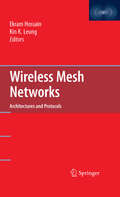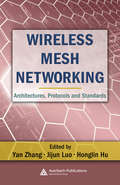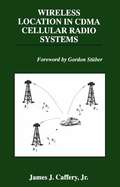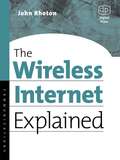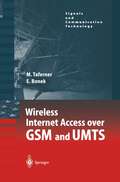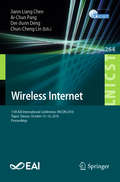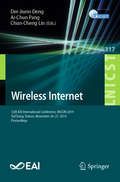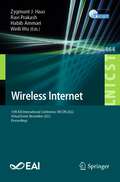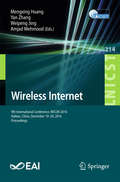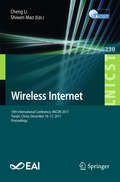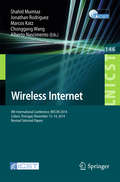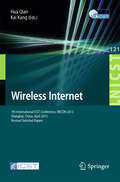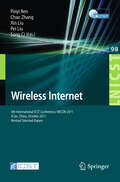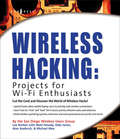- Table View
- List View
Wireless Mesh Networks: Architectures and Protocols
by Ekram Hossain Kin K. LeungThis book collects articles featuring recent advances in the theory and applications of wireless mesh networking technology. The contributed articles, from the leading experts in the field, cover both theoretical concepts and system-level implementation issues. The book starts with the essential background on the basic concepts and architectures of wireless mesh networking and then presents advanced level materials in a step-by-step fashion.
Wireless Mesh Networking: Architectures, Protocols and Standards
by Yan Zhang Jijun Luo Honglin HuA promising new technology, wireless mesh networks are playing an increasingly important role in the future generations of wireless mobile networks. Characterized by dynamic self-organization, self-configuration, and self-healing to enable quick deployment, easy maintenance, low cost, high scalability, and reliable services, this technology is beco
Wireless Location in CDMA Cellular Radio Systems (The Springer International Series in Engineering and Computer Science #535)
by James J. Caffery, Jr.With the increasing market penetration of cellular telephones, the number of E-911 calls placed by cellular telephones has grown cons- erably. This growth in E-911 calls led to a 1996 FCC ruling requiring that all cellular, PCS, and SMR licensees provide location information for the support of E-911 safety services. The provision of such location information is to be implemented in two phases. Phase I, whose deadline has already been passed, requires that wireless carriers relay the caller’s telephone number along with location of the cell site and/or sector se- ing the call, to a designated Public Safety Answering Point (PSAP). This information allows the PSAP to return the call if disconnected. Phase II, to be completed by October 1, 2001, is much more stringent and requires that the location of an E-911 caller be determined and reported with an rms location accuracy of 125 m in 67% of the cases. The applications of wireless location technology extend well beyond E-911 services. Location information can be used by cellular telephone operators themselves for more effective management of their radio - sources, so as to achieve greater spectral efficiencies. Resource m- agement algorithms such as hand-offs between cell sites, channel assi- ments, and others can all benefit from subscriber location information. Location information obtained from vehicular based cellular telephones can be used as an input to Intelligent Transportation Systems (ITS), and in particular traffic management and traveler information systems.
The Wireless Internet Explained (HP Technologies)
by John RhotonThe Wireless Internet Explained covers the full spectrum of wireless technologies from a wide range of vendors, including initiatives by Microsoft and Compaq. The Wireless Internet Explained takes a practical look at wireless technology. Rhoton explains the concepts behind the physics, and provides an overview that clarifies the convoluted set of standards heaped together under the umbrella of wireless. It then expands on these technical foundations to give a panorama of the increasingly crowded landscape of wireless product offerings. When it comes to actual implementation the book gives abundant down-to-earth advice on topics ranging from the selection and deployment of mobile devices to the extremely sensitive subject of security. Written by an expert on Internet messaging, the author of Digital Press's successful Programmer's Guide to Internet Mail and X.400 and SMTP: Battle of the E-mail Protocols, The Wireless Internet Explained describes and evaluates the current state of the fast-growing and crucial field of wireless communications.Covers phone-based systems, PDAs and the wireless office Describes and evaluates the current state of the fast- growing and crucial field of wireless communications
Wireless Internet Access over GSM and UMTS (Signals and Communication Technology)
by Manfred Taferner Ernst BonekThis is the only book of its scope to comprehensively investigate the performance and problems of the Transmission Control Protocol/Internet Protocol (TCP/IP) protocol stack. It is an ideal reference work giving valuable advice on protocols, transmission modes, and coding schemes.
Wireless Internet: 11th EAI International Conference, WiCON 2018, Taipei, Taiwan, October 15-16, 2018, Proceedings (Lecture Notes of the Institute for Computer Sciences, Social Informatics and Telecommunications Engineering #264)
by Jiann-Liang Chen Ai-Chun Pang Der-Jiunn Deng Chun-Cheng LinThis book constitutes the refereed post-conference proceedings of the 11th International Conference on Wireless Internet , WiCON 2018, held in Taipei, Taiwan, in October 2018. The 36 full papers were selected from 79 submissions and are grouped into the following topics: wireless network, artificial intelligence, security, IoT, location-based services, financial applicatiosn, vehicular ad hoc network, services and applications.
Wireless Internet: 12th EAI International Conference, WiCON 2019, TaiChung, Taiwan, November 26–27, 2019, Proceedings (Lecture Notes of the Institute for Computer Sciences, Social Informatics and Telecommunications Engineering #317)
by Der-Jiunn Deng Ai-Chun Pang Chun-Cheng LinThis book constitutes the refereed post-conference proceedings of the 12th International Conference on Wireless Internet, WiCON 2019, held in TaiChung, Taiwan, in November 2019. The 39 full papers were selected from 79 submissions and are grouped into the following topics: Ad hoc and sensor network, artificial intelligence, security and blockchain, internet of things, wireless internet, services and applications.
Wireless Internet: 15th EAI International Conference, WiCON 2022, Virtual Event, November 2022, Proceedings (Lecture Notes of the Institute for Computer Sciences, Social Informatics and Telecommunications Engineering #464)
by Zygmunt J. Haas Ravi Prakash Habib Ammari Weili WuThis book constitutes the refereed post-conference proceedings of the 15th International Conference on Wireless Internet, WiCON 2022, held in November 2022. Due to COVID-19 pandemic the conference was held virtually. The 16 full papers were selected from 45 submissions and are grouped into the following topics: Security and privacy; blockchain and wireless networks; Resource management, routing, and internet computing; social networks and learning.
Wireless Internet: 9th International Conference, WICON 2016, Haikou, China, December 19-20, 2016, Proceedings (Lecture Notes of the Institute for Computer Sciences, Social Informatics and Telecommunications Engineering #214)
by Mengxing Huang Yan Zhang Weipeng Jing Amjad MehmoodThis book constitutes the refereed post-conference proceedings of the 9th International Conference on Wireless Internet, WICON 2016, held in Haikou, China, in December 2016. The 30 full and 4 poster papers were selected from 62 submissions and are grouped into the following topics: sensor networks, security, wireless networks, Internet of Things.
Wireless Internet: 10th International Conference, WiCON 2017, Tianjin, China, December 16-17, 2017, Proceedings (Lecture Notes of the Institute for Computer Sciences, Social Informatics and Telecommunications Engineering #230)
by Cheng Li Shiwen MaoThis book constitutes the refereed post-conference proceedings of the 10th International Conference on Wireless Internet , WiCON 2017, held in Tianjin, China, in December 2017. The 42 full papers were selected from 70 submissions and cover the following topics: wireless networking, massive MIMO and mmWave, WSNs and VANETs, security and IoT, wireless communications, cloud and big data networking.
Wireless Internet: 16th EAI International Conference, WiCON 2023, Athens, Greece, December 15-16, 2023, Proceedings (Lecture Notes of the Institute for Computer Sciences, Social Informatics and Telecommunications Engineering #527)
by Leandros A. Maglaras Christos DouligerisThis book constitutes the refereed post-conference proceedings of the 16th International Conference on Wireless Internet, WiCON 2023, held in Athens, Greece, in December 15-16, 2023. The 14 full papers were selected from 35 submissions and are grouped into the following topics: Wireless networks; AI/ML systems; 5G/6G networks; and Digital services.
Wireless Internet: 8th International Conference, WICON 2014, Lisbon, Portugal, November 13-14, 2014, Revised Selected Papers (Lecture Notes of the Institute for Computer Sciences, Social Informatics and Telecommunications Engineering #146)
by Shahid Mumtaz Jonathan Rodriguez Marcos Katz Chonggang Wang Alberto NascimentoThis book constitutes the thoroughly refereed post-conference proceedings of the 8th International Conference on Wireless Internet, WICON 2014, held in Lisbon, Portugal, in November 2014. The 45 revised full papers were carefully reviewed and selected from numerous submissions. The papers cover topics such as 5G mobile communications, Internet of Things (IoT), super Wi-Fi and V2V/V21.
Wireless Internet: 7th International ICST Conference, WICON 2013, Shanghai, China, April 11-12, 2013, Revised Selected Papers (Lecture Notes of the Institute for Computer Sciences, Social Informatics and Telecommunications Engineering #121)
by Hua Qian Kai KangThis book constitutes the thoroughly refereed post-conference proceedings of the 7th International ICST Conference on Wireless Internet, WICON 2013, held in Shanghai, China, in April 2012. The 20 revised full papers were carefully reviewed and selected from numerous submissions. The papers cover topics such as vehicular communications and heterogeneous networks, cognitive radio and multi-antenna systems, networks and beyond, ad hoc and mesh networks.
Wireless Internet: 6th International ICST Conference, WICON 2011, Xi'an, China, October 19-21, 2011, Revised Selected Papers (Lecture Notes of the Institute for Computer Sciences, Social Informatics and Telecommunications Engineering #98)
by Pinyi Ren Chao Zhang Xin Liu Pei Liu Song CiThis book constitutes the thoroughly refereed post-conference proceedings of the 6th International ICST Conference on Wireless Internet (WICON 2011) held in Xi’an, Shaanxi, China in October 2011. The 55 revised full papers were carefully selected from numerous submissions and focus on research in telecommunication and networking and development in information and communication technologies. The papers are presented in 10 technical sessions and cover topics as video streaming over OFDMA downlink systems, cognitive radio networks, distributed antenna systems, joint source channel coding, multiuser MIMO systems, signal detection, frequency synchronization in 3GPP LTE systems, visual cognitive radio, wireless relay networks, and network flow identifying methods.
Wireless Information Networks: Architecture, Resource Management, and Mobile Data (The Springer International Series in Engineering and Computer Science #351)
by Jack M. HoltzmanIn April 1995, WINLAB (the Wireless Infonnation Network Lab oratory at Rutgers University) hosted the Fifth WINLAB Workshop on Third Generation Wireless Infonnation Networks. This workshop brings together a select group of experts interested in the future of Personal Communications, Mobile Computing and other services supported by wireless communications. As a sequel to Kluwer books on previous WINLAB workshops,l this volume assembles written versions of presentations of the Fifth Workshop. The last few years have been exciting for the field of wireless communications. The second generation systems that have absorbed our attention during those years are becoming commercial realities. Everyone is looking forward to PCS, especially in light of the recent auctions. We see an explosion of technical alternatives for meeting the demand for wireless communications. We also have applications in search of the best technologies rather than the reverse. The papers included provide new insights into many of the issues needing resolution for the successful introduction of the new services by the end of the decade. The authors represent views from both industry and universities from a number of nations. They are grouped into four main categories: Architecture, Radio Resource Management, Access, and Mobile Data, Mobile Networks.
Wireless Information and Power Transfer: A New Paradigm for Green Communications
by Dushantha Nalin Jayakody John Thompson Symeon Chatzinotas Salman DurraniThis book presents breakthroughs in the design of Wireless Energy Harvesting (WEH) networks. It bridges the gap between WEH through radio waves communications and power transfer, which have largely been designed separately. The authors present an overview of the RF-EHNs including system architecture and RF energy harvesting techniques and existing applications. They also cover the idea of WEH in novel discoveries of information, the theoretical bounds in WEH, wireless sensor networks, usage of modern channel coding together with WEH, energy efficient resource allocation mechanisms, distributed self-organized energy efficient designs, delay-energy trade-off, specific protocols for energy efficient communication designs, D2D communication and energy efficiency, cooperative wireless networks, and cognitive networks.
Wireless Indoor Localization: A Crowdsourcing Approach
by Chenshu Wu Zheng Yang Yunhao LiuThis book provides a comprehensive and in-depth understanding of wireless indoor localization for ubiquitous applications. The past decade has witnessed a flourishing of WiFi-based indoor localization, which has become one of the most popular localization solutions and has attracted considerable attention from both the academic and industrial communities. Specifically focusing on WiFi fingerprint based localization via crowdsourcing, the book follows a top-down approach and explores the three most important aspects of wireless indoor localization: deployment, maintenance, and service accuracy. After extensively reviewing the state-of-the-art literature, it highlights the latest advances in crowdsourcing-enabled WiFi localization. It elaborated the ideas, methods and systems for implementing the crowdsourcing approach for fingerprint-based localization. By tackling the problems such as: deployment costs of fingerprint database construction, maintenance overhead of fingerprint database updating, floor plan generation, and location errors, the book offers a valuable reference guide for technicians and practitioners in the field of location-based services. As the first of its kind, introducing readers to WiFi-based localization from a crowdsourcing perspective, it will greatly benefit and appeal to scientists and researchers in mobile and ubiquitous computing and related areas.
Wireless Home Networking For Dummies
by Danny Briere Pat HurleyThe perennial bestseller shows you how share your files and Internet connection across a wireless network Fully updated for Windows 7 and Mac OS X Snow Leopard, this new edition of this bestseller returns with all the latest in wireless standards and security. This fun and friendly guide shows you how to integrate your iPhone, iPod touch, smartphone, or gaming system into your home network. Veteran authors escort you through the various financial and logisitical considerations that you need to take into account before building a wireless network at home. Covers the basics of planning, installing, and using wireless LANs Reviews essential information on the latest security issues Delivers valuable tips on how to stay current with fast-moving technology Discusses how to share resources such as printers, scanners, an Internet connection, files, and more with multiple computers on one network Wireless Home Networking For Dummies, 4th Edition skips the technical jargon and gets you connected with need-to-know information on building a wireless home network.
Wireless Home Networking For Dummies
by Danny Briere Pat HurleyThe perennial bestseller shows you how share your files and Internet connection across a wireless network Fully updated for Windows 7 and Mac OS X Snow Leopard, this new edition of this bestseller returns with all the latest in wireless standards and security. This fun and friendly guide shows you how to integrate your iPhone, iPod touch, smartphone, or gaming system into your home network. Veteran authors escort you through the various financial and logisitical considerations that you need to take into account before building a wireless network at home. Covers the basics of planning, installing, and using wireless LANs Reviews essential information on the latest security issues Delivers valuable tips on how to stay current with fast-moving technology Discusses how to share resources such as printers, scanners, an Internet connection, files, and more with multiple computers on one network Wireless Home Networking For Dummies, 4th Edition skips the technical jargon and gets you connected with need-to-know information on building a wireless home network.
Wireless Health (SpringerBriefs in Computer Science)
by Honggang Wang Md Shaad Mahmud Hua Fang Chonggang WangThis book provides a candid assessment and practical knowledge about the current technological advancements of the wireless healthcare system. This book presents the competencies of modeling e-health framework, medical wireless body sensor networks, communication technologies for mobile health, nanotechnology innovations in medicine, security issues for medical records, personalized services in healthcare applications, and Big Data for wireless health. This book covers multiple research perspectives in order to address the strong need for interdisciplinary research in the area of wireless health, such as the interactive research among biomedical sensor technology, intelligent textiles and advanced wireless network technology. The interactions involve experts from multidisciplinary fields including medical, information technology and computing fields. Designed as a study tool for graduate students, researchers, and medical professionals, this book is also valuable for business managers, entrepreneurs, and investors within the medical and healthcare industries. It is useful for anyone who cares about the future opportunities in healthcare systems.
Wireless Hacking: Cut the cord and discover the world of wireless hacks!
by Lee BarkenSales of wireless LANs to home users and small businesses will soar this year, with products using IEEE 802.11 (Wi-Fi) technology leading the way, according to a report by Cahners research. Worldwide, consumers will buy 7.3 million wireless LAN nodes--which include client and network hub devices--up from about 4 million last year. This third book in the "HACKING" series from Syngress is written by the SoCalFreeNet Wireless Users Group and will cover 802.11a/b/g (“Wi-Fi") projects teaching these millions of Wi-Fi users how to "mod" and "hack" Wi-Fi access points, network cards, and antennas to run various Linux distributions and create robust Wi-Fi networks.Cahners predicts that wireless LANs next year will gain on Ethernet as the most popular home network technology. Consumers will hook up 10.9 million Ethernet nodes and 7.3 million wireless out of a total of 14.4 million home LAN nodes shipped. This book will show Wi-Fi enthusiasts and consumers of Wi-Fi LANs who want to modify their Wi-Fi hardware how to build and deploy “homebrew" Wi-Fi networks, both large and small.Wireless LANs next year will gain on Ethernet as the most popular home network technology. Consumers will hook up 10.9 million Ethernet nodes and 7.3 million wireless clients out of a total of 14.4 million home LAN nodes shipped.This book will use a series of detailed, inter-related projects to teach readers how to modify their Wi-Fi hardware to increase power and performance to match that of far more expensive enterprise networking products. Also features hacks to allow mobile laptop users to actively seek wireless connections everywhere they go!The authors are all members of the San Diego Wireless Users Group, which is famous for building some of the most innovative and powerful "home brew" Wi-Fi networks in the world.
Wireless Crime and Forensic Investigation
by Gregory KipperSecurity is always a concern with any new technology. When we think security we typically think of stopping an attacker from breaking in or gaining access. From short text messaging to investigating war, this book explores all aspects of wireless technology, including how it is used in daily life and how it might be used in the future. It provides a one-stop resource on the types of wireless crimes that are being committed and the forensic investigation techniques that are used for wireless devices and wireless networks. The author provides a solid understanding of modern wireless technologies, wireless security techniques, and wireless crime techniques, and shows how to conduct forensic analysis on wireless devices and networks. Each chapter, while part of a greater whole, is self-contained for quick comprehension.
Wireless Coordinated Multicell Systems: Architectures and Precoding Designs (SpringerBriefs in Computer Science)
by Duy H. Nguyen Tho Le-NgocThis SpringerBrief discusses the current research on coordinated multipoint transmission/reception (CoMP) in wireless multi-cell systems. This book analyzes the structure of the CoMP precoders and the message exchange mechanism in the CoMP system in order to reveal the advantage of CoMP. Topics include interference management in wireless cellular networks, joint signal processing, interference coordination, uplink and downlink precoding and system models. After an exploration of the motivations and concepts of CoMP, the authors present the architectures of a CoMP system. Practical implementation and operational challenges of CoMP are discussed in detail. Also included is a review of CoMP architectures and deployment scenarios in the LTE-Advanced standard. Readers are exposed to the latest multiuser precoding designs for the CoMP system under two operating modes, interference aware and interference coordination. Wireless Coordinated Multi cell Systems: Architectures and Precoding Designs is a concise and approachable tool for researchers, professionals and advanced-level students interested in wireless communications and networks.
Wireless Communications under Hostile Jamming: Security and Efficiency
by Tongtong Li Tianlong Song Yuan LiangThis monograph is intended for the designers and would-be designers of secure and efficient wireless communication systems under intentional interference. Along with the widespread of wireless devices, especially reconfigurable software defined radios, jamming has become a serious threat to civilian communications. In this book, going beyond traditional communication system design that mainly focuses on accurate information transmission under benign environments, we aim to enhance the physical layer security of communication systems by integrating modern cryptographic techniques into transceiver design, so as to achieve secure high-speed transmission under hostile interference with high reliability and efficiency. We revisit existing jamming patterns, and introduce new jamming patterns. We analyze the weaknesses of existing anti-jamming techniques. We present innovative and feasible anti-jamming techniques, which can strengthen the inherent security of the 3G, 4G and the upcoming 5G systems with minimal and inexpensive changes to the existing CDMA, frequency hopping and OFDM schemes. We also provide benchmarks for system performance evaluation under various jamming scenarios through capacity analysis. This book includes design principles, in-depth theoretical analysis and practical design examples, and will be of interest to academic researchers as well as professionals in industry.
Wireless Communications Systems and Networks (Information Technology: Transmission, Processing and Storage)
by Mohsen GuizaniSince the early 1990s, the wireless communications field has witnessed explosive growth. The wide range of applications and existing new technologies nowadays stimulated this enormous growth and encouraged wireless applications. The new wireless networks will support heterogeneous traffic, consisting of voice, video, and data (multimedia). This necessitated looking at new wireless generation technologies and enhance its capabilities. This includes new standards, new levels of Quality of Service (QoS), new sets of protocols and architectures, noise reduction, power control, performance enhancement, link and mobility management, nomadic and wireless networks security, and ad-hoc architectures. Many of these topics are covered in this textbook. The aim of this book is research and development in the area of broadband wireless communications and sensor networks. It is intended for researchers that need to learn more and do research on these topics. But, it is assumed that the reader has some background about wireless communications and networking. In addition to background in each of the chapters, an in-depth analysis is presented to help our readers gain more R&D insights in any of these areas. The book is comprised of 22 chapters, written by a group of well-known experts in their respective fields. Many of them have great industrial experience mixed with proper academic background.
